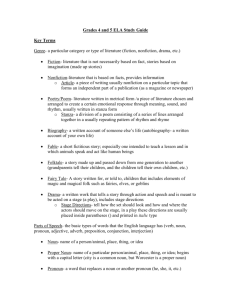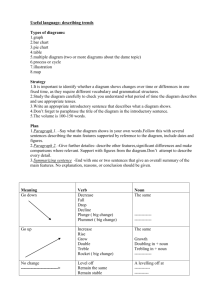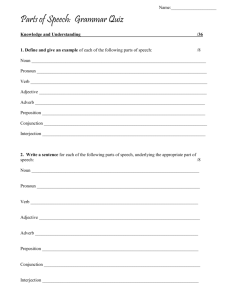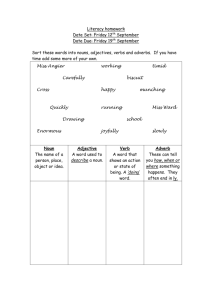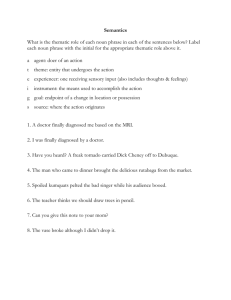Grade 3 ELA Study Guide - Seven Hills Charter Public School
advertisement
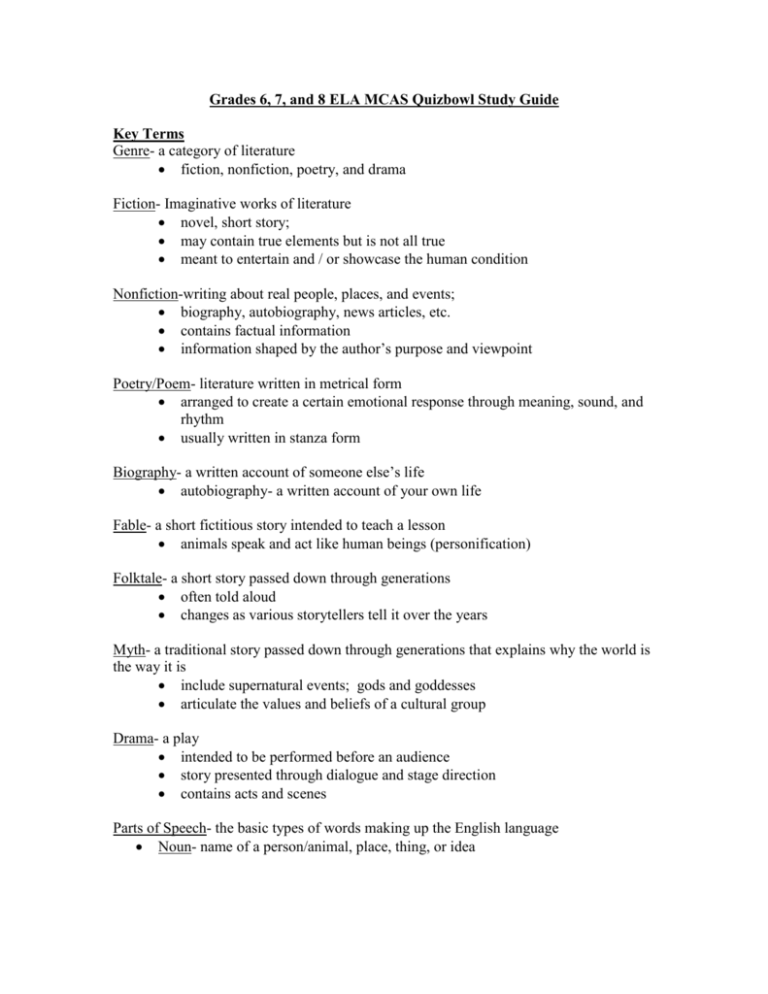
Grades 6, 7, and 8 ELA MCAS Quizbowl Study Guide Key Terms Genre- a category of literature fiction, nonfiction, poetry, and drama Fiction- Imaginative works of literature novel, short story; may contain true elements but is not all true meant to entertain and / or showcase the human condition Nonfiction-writing about real people, places, and events; biography, autobiography, news articles, etc. contains factual information information shaped by the author’s purpose and viewpoint Poetry/Poem- literature written in metrical form arranged to create a certain emotional response through meaning, sound, and rhythm usually written in stanza form Biography- a written account of someone else’s life autobiography- a written account of your own life Fable- a short fictitious story intended to teach a lesson animals speak and act like human beings (personification) Folktale- a short story passed down through generations often told aloud changes as various storytellers tell it over the years Myth- a traditional story passed down through generations that explains why the world is the way it is include supernatural events; gods and goddesses articulate the values and beliefs of a cultural group Drama- a play intended to be performed before an audience story presented through dialogue and stage direction contains acts and scenes Parts of Speech- the basic types of words making up the English language Noun- name of a person/animal, place, thing, or idea Proper Noun- name of a particular person/animal, place, thing, or idea; begins with a capital letter (city is a common noun, but Worcester is a proper noun) Pronoun- a word that replaces a noun or another pronoun (he, she, it, etc.) Verb- a word that shows action or state of being (ran, is) Adverb- a word that modifies a verb, an adjective, or another adverb. An adverb tells how, when, where, why, how often, or how much; often ends in -ly Adjective- a word that describes a noun (happy), Adjectives either come before a noun, or after linking verbs (be, seem, look). Preposition- a word that shows the relationship between a noun or a pronoun (over, around). A preposition through its object (the noun or pronoun) becomes known as a prepositional phrase (The dog dug under the fence). Conjunction- a word or expression that joins together sentences, clauses, phrases, or words (“and” is a conjunction in this sentence: I ate the pizza and the pasta.) Interjection- a word added to a sentence to convey emotion, (“ouch” and “oh no” are interjections in the following sentences: Ouch, that hurt! Oh no, I forgot that the test was today. ) Antonyms- words that have opposite meanings (hot/cold) Synonyms- words that have similar (about the same) meanings (happy/glad) Story Elements- the important pieces that make up a story (character, setting, plot, etc.) Character- a person who takes part in the action of a story, novel, or a play o Sometimes characters can be animals or imaginary creatures, such as beings from another planet. Plot- the action or sequence of events in a story; usually a series of related incidents that builds and grows as the story develops o There are five basic elements in a plot line: (a) exposition; (b) rising action; (c) climax; (d) falling action; and (e) resolution Setting- when and where the story takes place Problem/Conflict- the struggle between the opposing forces that moves the plot forward o Internal Conflict - occurring within a character, o External Conflict - occurring between characters or between a character and an abstraction such as nature or fate Solution / Resolution- how the problem in the story is solved/worked out Lesson/Moral- what the story is trying to teach Stanza- a division of a poem consisting of a series of lines arranged together Usually a repeating pattern of rhythm and rhyme Mood- the feeling or atmosphere that a writer creates for the reader; Created through the use of connotation, details, dialogue, imagery, figurative language, foreshadowing, setting, and rhythm Figurative language - language that communicates ideas beyond the ordinary or literal meaning of the words (simile or metaphor), often used to make writing more interesting or entertaining Simile- a comparison of two different things by using the word like or as (eyes like stars) Metaphor- a comparison between two things that are basically different but have something in common; (He is a tiger when he is angry.) a metaphor does not contain the words like or as. Opinion- a judgment about a person or thing not based on facts, how someone feels about something (Chocolate ice cream is the best!) Fact- a piece of information about something presented as true and accurate (There are seven days in a week.) Purpose- what something is used for; why an author wrote a text or portion of a text in a particular manner Parentheses- ( ) marks used to enclose a word, phrase, or sentence inserted in a passage to explain or comment on it Italics- this slanted letters that look like Italics are most often used to emphasize certain words, to indicate that they are in a foreign language, or to set off the title of a literary or artistic work. Bold Face- a type having thick dark lines, boldface creates emphasis often used for captions, subheadings and stand-alone words and phrases Dashes- punctuation mark -- that is used chiefly to indicate a break in the thought or structure of a sentence Root or Base Word- a word to which prefixes and suffixes may be added to make other words Prefix- a word part that is added to the beginning of a base word that changes the sense or meaning of the root or base word. (re-, dis-, com- ) Suffix - a word part that is added to the ending of a root word and establishes the part of speech of that word. the suffix -ly added to immediate, a noun, creates the word, immediately, an adverb or adjective Stage Directions- tell how the set should look and how and where the actors should move on the stage, in a play these directions are usually placed inside parentheses ( ) and printed in italic type Context Clues- words or phrases in a text that can be used to help with the understanding of unknown words Excerpt- a passage or quotation taken or selected from a book, document, film, etc. Key Concepts Genre-fiction, non fiction, biography, poetry, fables, folktales, fairytales, etc. Student should be able to determine what genre a passage is and why it is this type of genre. Here is an example of a question relating to genre: “Which of these quotes from the myth helps the reader identify the story as a myth?” Structure/Mechanics of English Language Students should have an understanding of the English language and how it works (sentence structure, punctuation, and other mechanics such as italics and boldface). Here are a few examples of questions relating to the structure/mechanics of the English language: o “In paragraph 1, why are the words Humpty Dumpty printed in italics (slanted print)?” o “In paragraph 8, why is one sentence in bold print?” o “At the end of paragraph 3, what is the purpose of setting apart the phrase “-more than anywhere else-“with dashes?” Origins of English Language: Students should be able to identify words or word parts in the English language that have come from other languages and use this information to help them determine the meanings of words. Here are a few examples of questions relating to origins of the English Language: o “The word neurotoxin in section 2 comes from the Greek word neuro, which means “nerve,” and the Latin word toxius, which means “poison.” Which phrase best defines the word neurotoxin?” o “Which part of the word biologists means “living” or “life”?” Parts of Speech-noun (proper/common), pronoun, verb, adjective, adverb, preposition, conjunction, interjection); Students should be able to identify parts of speech of words from the passages. Here is a question relating to parts of speech: o “The phrase “never-see-this-again” is used as which part of speech in this excerpt?” General Grammar-types of words: antonyms, synonyms, contractions, compound words Here are a few examples of questions relating to grammar: o “Which of the following is the best synonym for the word enchanted in paragraph 1?” o “Which of the following is the best replacement for quench?” Multiple Meaning Words-some words have more than one meaning Students should be able to determine the meaning of a word based on how it is used in a passage. Here are a few examples of questions relating to multiple meaning words: o “What meaning of the word low is used in the sentence?” o “Which of the following is the best definition of the word volume as it is used in paragraph 3?” o “Which meaning of the word subjects is used in the sentence?” Vocabulary-Word Meanings Students should be able to determine the meaning of a word based on how it is used in context. Here are a few examples of questions relating to vocabulary: o “In the sentence, what does the word extracted most likely mean?” o “Based on the sentence, what is the most likely meaning of the word concocting?” o “Which of the following best describes a connoisseur?” o “Which of the following context clues helps the reader understand the meaning of annotations in paragraph 7?” Analyzing/Interpreting Poetry- Students should be able to read poems and understand their meaning. Here is an example of a question relating to poetry: o “What mood is conveyed by the phrase “wild winds blows” in stanza 1?” General Test Taking Strategies for Multiple Choice Questions Read the question twice and underline/highlight any key information. Refer back to the passages to help you answer questions (look for clues in the passage). Read all the possible answer choices before choosing your answer. Some questions have more than one correct answer but ask you to identify the one that is “BEST” or “MOST LIKLEY” Look for discrete differences between choices. Use process of elimination-cross out the answers you know are wrong Don’t leave any blank Most of the time, you will find answers in the passage in the same order the questions are asked, (first questions have answers at the beginning of the passage and answers to the last questions are usually found at the end of the passage) Read all the information on the page including introductory information and captions (they often have helpful information in them)


